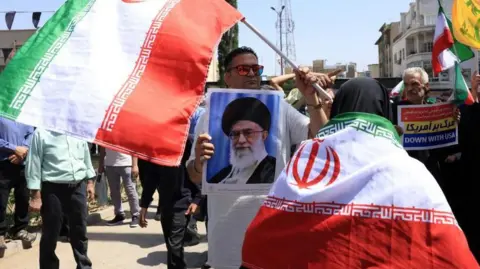In the wake of recent Israeli operations, serious questions are emerging regarding the security and intelligence capabilities of Iran, particularly within the ranks of the Islamic Revolutionary Guard Corps (IRGC) and its elite unit, the Quds Force. Recent targeted assassinations have highlighted a troubling breach of security, signaling possible vulnerabilities within Iran’s intelligence community.
Two prominent figures targeted in these operations are Saeed Izadi and Behnam Shahryari. Izadi, a distinguished commander of the Quds Force responsible for coordinating with Hamas and various Palestinian armed factions, was reportedly eliminated in an apartment located in Qom, a Shia holy city. Meanwhile, Shahryari, who led “Unit 190” tasked with smuggling weapons and finances to Iran’s regional allies, met his demise in a drone strike while on the move in western Iran. The implications of these assassinations extend far beyond the immediate loss of personnel; they strike at the very heart of Iran’s operational capabilities in a region rife with tension.
Izadi’s role was particularly notable in the lead-up to Hamas’s devastating attack on Israel on October 7, 2023. The head of Israel’s military, Eyal Zamir, articulated the significance of Izadi’s death, framing it as a critical juncture in what he described as a nascent multi-front war. Zamir emphasized the weight of Izadi’s actions, asserting, “The blood of thousands of Israelis is on his hands,” and classified the assassination as a substantial intelligence and operational success.
Military sources underline that Izadi had previously narrowly escaped a targeted Israeli airstrike in April 2024 that was conducted against the Iranian consulate in Damascus, resulting in high-ranking casualties from the Quds Force. This recent wave of targeted killings underscores a broader trend focused on Iranian military leadership that raises alarms about the integrity and security of Iran’s internal intelligence mechanisms. Many observers are beginning to interpret these developments as indicative of a growing fracture within the Iranian intelligence apparatus.
In a wider context, Iranian state television recently broadcast visuals of concealed vehicles alleged to have been utilized for drone transportation, further illustrating ongoing conflicts involving espionage and militarized engagements. Reports indicate that numerous individuals have been detained under accusations of spying for Mossad, Israel’s national intelligence agency. Human rights organizations have expressed concerns that these allegations might be leveraged by Iranian authorities as a pretext to streamline arrests of dissenters and critics of the IRGC and governmental policies.
The Iranian leadership appears increasingly paranoid, evident in recent directives ordering personnel to refrain from using internet-connected smartphones for communications. There are ongoing appeals to the public to report any suspicious activity related to property rentals or unusual behavior that could denote espionage activities.
Historically, the covert banking of power between Iran and Israel has manifested through a lengthy series of clandestine operations, including cyberattacks, targeted killings, and sabotage. Notable incidents, such as the 2018 infiltration by Mossad agents into a secure Iranian warehouse that resulted in the extraction of classified nuclear documents, underscore the extensive penetration of Israeli intelligence into Iran’s operations.
The aftermath of such operations continues to manifest in horrifying reality, with Iran’s past vulnerabilities, such as the assassination of nuclear scientist Mohsen Fakhrizadeh in 2020, accentuating the collapse of security protocols. These failures are compounded by revelations regarding internal betrayal, with former Iranian officials suggesting that the Mossad’s reach extends even into Iran’s own counterintelligence operations.
In the broader scope of Israeli-Iranian tensions, recent attacks have aimed not only at known military figures but also at integral facilities suspected of supporting nuclear development. As Iranian leaders grapple with the implications of these incidents, the consensus is growing: Iran’s internal security is vulnerable, and the consequences of that vulnerability could reshape regional dynamics significantly. As events continue to evolve, both Iran and Israel remain locked in a conflict characterized by a profound and escalating level of distrust.



